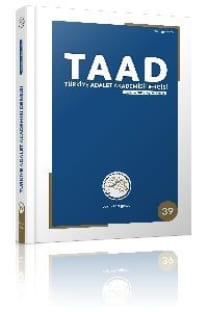CEZA MUHAKEMESİ HUKUKUNDA TANIK
Tanık beyanı, ispat vasıtalarından olan beyan delilinin bir çeşididir ve maddi gerçeğin ortaya çıkartılmasında etkili rol oynadığı tartışılmazdır. Tanık beyanının sözlü olması ve yargı mercilerin huzurunda verilmesi esastır. Ancak bazı zorunlu hallerde tanığın istinabe veya SEGBİS yoluyla dinlenilmesi söz konusu olabilmektedir. Tanık, muhakemenin tarafı olmamakla birlikte beş duyusu vasıtasıyla olayı görgüsü ve bilgisi dahilinde aktaran kişiye denilmektedir. Ancak tanık, bazen beş duyusu ile algıladığı olayları değil de başkalarında duyduğu bilgileri de aktarabilmektedir. Bu durumda doğrudan tanık beyanı ile dolaylı tanık beyanı arasında delil değerinin farklılık arz ettiği ise aşikardır. Tanık ceza muhakemesinin süjesi değil, en önemli ispat vasıtalarındandır. Tanıklık kamusal bir görevdir. Bu sebeple tanıklık görevi kanunumuzda belli yetki ve yükümlülükler ile donatılmıştır. Tanık, tanıklıktan çekinme ve tazminat isteme hakkına sahiptir. Aynı zamanda bazı hallerde tanıklıktan çekinme, hazır bulunma, beyanda bulunma ve yemin etme yükümlülüğü altındadır. Tanıklık müessesesi gerek 5271 sayılı “Ceza Muhakemesi Kanunu’nda” gerekse 5726 sayılı “Tanık Koruma Kanunu’nda” düzenlenmiştir. Tanığın maddi gerçeğin ortaya çıkmasında etkin rol oynaması, tanığı bazı hallerde tehlikeli konuma getirebilmektedir. Tanığın bu tehlikeli duruma karşı kendini güvende hissetmesi ve tanıklıktan kaçınmasının önüne geçilmesi için yargı mercileri tarafından gerekli tedbirler alınmalıdır. Tanık sahip olduğu hakları kullanırken veya tanığın korunması için getirilen tedbirler yerine getirilirken sanığın savunma hakkını ve adil yargılanma ilkesini ihlal etmeden, orantılılık ilkesini koruyarak hareket edilmelidir.
Anahtar Kelimeler:
Tanık, , tanık beyanı, , delil, , tank koruma, , yemin,
Witness statement is a kind of statement evidence which is one of the means of proof and it is indisputable that it plays an effective role in revealing the material truth. It is essential that the witness statement be verbal and given before the judicial authorities. However, in some compulsory situations, the witness may be heard through rogatory or SEGBİS. Although a witness is not a party to the judgment, it is called a person who conveys the event with his experience and knowledge through his five senses. However, the witness can sometimes convey not only the events perceived with his five senses but also the information he / she has heard in others. In this case, it is obvious that the value of evidence differs between direct witness statement and indirect witness statement. The witness is not the subject of the criminal procedure, it is one of the most important means of proof. Testimony is a public duty. For this reason, the duty of witnessing is equipped with certain powers and obligations in our law. The witness has the right to refrain from witnessing and to seek compensation. At the same time, he is under the obligation to refrain from witnessing, to be present, to make statements and to take an oath in some cases. The testimony institution has been regulated both in the “Criminal Procedure Code” numbered 5271 and “Witness Protection Law” numbered 5726. The fact that the witness plays an active role in revealing the material truth may put the witness in a dangerous position in some cases. Necessary measures should be taken by the judicial authorities in order to prevent the witness from feeling safe against this dangerous situation and avoiding testimony. While the witness is exercising his rights or taking measures to protect the witness, action must be taken by protecting the principle of proportionality without violating the right of defense and the principle of a fair trial.
Keywords:
witness, , witness statement, , evidence, , witness protection, , oath, ,
___
- AKSAN, Murat, “Ceza Muhakemesi İşlemlerinde Hazır Bulunma”, Selçuk Üniversitesi Hukuk Fakültesi Dergisi, Cilt 11, Sayı 1-2, 2003, s 165-197,https://dergipark.org.tr/tr/download/article-file/262570, (Erişim Tarihi: 21.07.2020).
- AKDENİZ, Tugay, “Ceza Muhakemesinde Tanık Beyanı Delili”, Bahçeşehir Üniversitesi, Sosyal Bilimler Enstitüsü, Yüksek Lisans Tezi, İstanbul, 2015, file:///C:/Users/mm/Downloads/407890%20(1).pdf, (Erişim Tarihi: 14.10.2020).
- ALTIPARMAK, Cüneyd, “Türk Hukukunda Tanık Koruma”, Ankara Barosu Dergisi, Yıl 66,Sayı 1, Kış 2008, s. 171-179, http://www.ankarabarosu.org.tr/siteler/ankarabarosu/tekmakale/2008-1/10.pdf, ( Erişim Tarihi: 26.07.2020).
- BIÇAK, Vahit, Ceza Muhakemesi Hukuku, 4. Bası, Seçkin Yayıncılık, Ankara, Ekim, 2018, https://ws1.turcademy.com/ww/webviewer.php?doc=21248, (Erişim Tarihi: 24.10.2020).
- BİRTEK, Fatih, Ceza Muhakemesinde Delil ve İspat, 2. Baskı, Adalet Yayınevi, Ankara, 2017, https://ws1.turcademy.com/ww/webviewer.php?doc=17987, (Erişim Tarihi: 24.10.2020).
- CENTEL, Nur/ ZAFER, Hamide, Ceza Muhakemesi Hukuku, Yenilenmiş ve Gözden Geçirilmiş 18. Baskı, Beta Basım Yayın, İstanbul, Ekim, 2020.
- DEĞİRMENCİ, Olgun, “Ceza Muhakemesinde Tehlike İçinde Bulunan Tanığın Korunması”, TBB Dergisi, S. 83, 2009, s 73-122, http://tbbdergisi.barobirlik.org.tr/m2009-83-527 ,( Erişim Tarihi: 26.11.2019).
- DONAY, Süheyl, Ceza Yargılaması Hukuku, Güncellenmiş ve Genişletilmiş 2. Baskı, Beta Yayıncılık, İstanbul, Eylül 2012.
- FEYZİOĞLU, Metin, Ceza Hukuku Muhakemesinde Tanıklık, Ankara 1996.
- GÜROL, Candaş, “Tanığın Korunması ve Adil Yargılanma Hakkı”, TBB Dergisi, Sayı 60, 2005, s 44-54, http://tbbdergisi.barobirlik.org.tr/m2005-60-169 ,( Erişim Tarihi: 26.07.2020).
- GÜNGÖR, Devrim , “Ceza Muhakemesinde Tanık Beyanının Delil Değeri Üzerine Bazı Tespit ve Değerlendirmeler”, İnönü Üniversitesi Hukuk Fakültesi Dergisi Cilt 6, Sayı 2, 2015, s 307-318,
- https://dergipark.org.tr/en/download/article-file/208354, ( Erişim Tarihi: 21.07.2020).
- İPEK, Ali İhsan, Suça Sürüklenen Çocukların Muhakemesi, Adalet Yayınevi, Ankara, 2014.
- ISSN: 1309-6826
- Başlangıç: 2010
- Yayıncı: Türkiye Adalet Akademisi
Sayıdaki Diğer Makaleler
THOMAS AQUİNAS’TAN ORHAN MÜNİR ÇAĞIL’A TEOLOJİK TABİİ HUKUK
YENİ BİR İDARİ SUÇ OLARAK COVID-19 SALGIN SÜRECİNDE İHDAS EDİLEN FAHİŞ FİYAT ARTIŞI
COVID-19 (KORONAVİRÜS) SALGINI VE YAŞAM HAKKI
VERGİ UYUŞMAZLIĞI ÇERÇEVESİNDE İNCELEME RAPORUNUN İHBARNAMEYE EKLENMEMESİNİN DEĞERLENDİRİLMESİ
CEZA MUHAKEMESİ HUKUKUNDA BEDEN MUAYENESİ VE VÜCUTTAN ÖRNEK ALINMASI
TÜRKİYE BÜYÜK MİLLET MECLİSİ’NDE “SÜREKLİLİK İLKESİ” ÇERÇEVESİNDE “ARA VERME” VE “TATİL” ÜZERİNE
İŞÇİLERİN ÖZEL NİTELİKLİ KİŞİSEL VERİLERİNİN KORUNMASI ve BUNDAN DOĞAN SORUMLULUK
